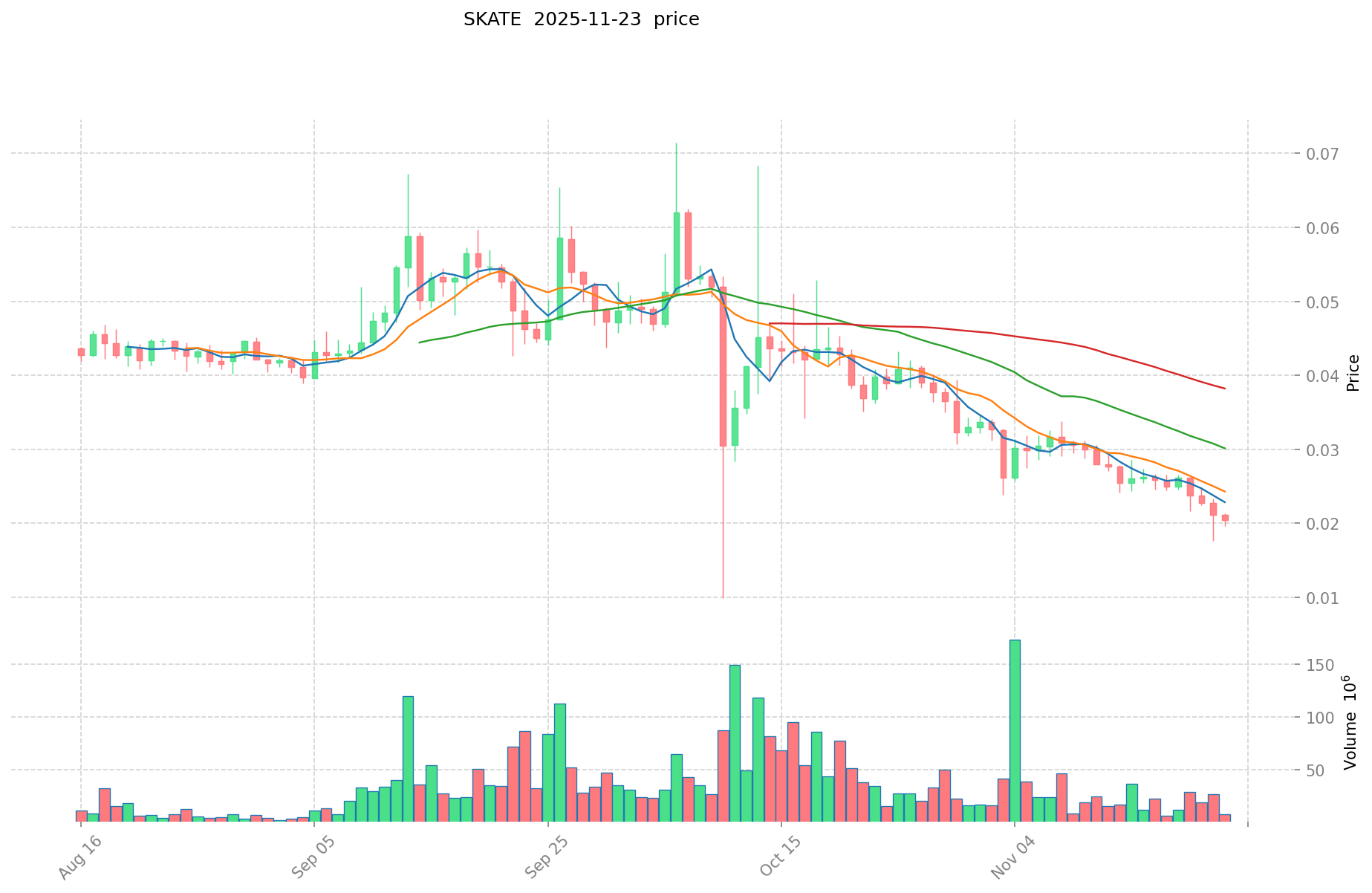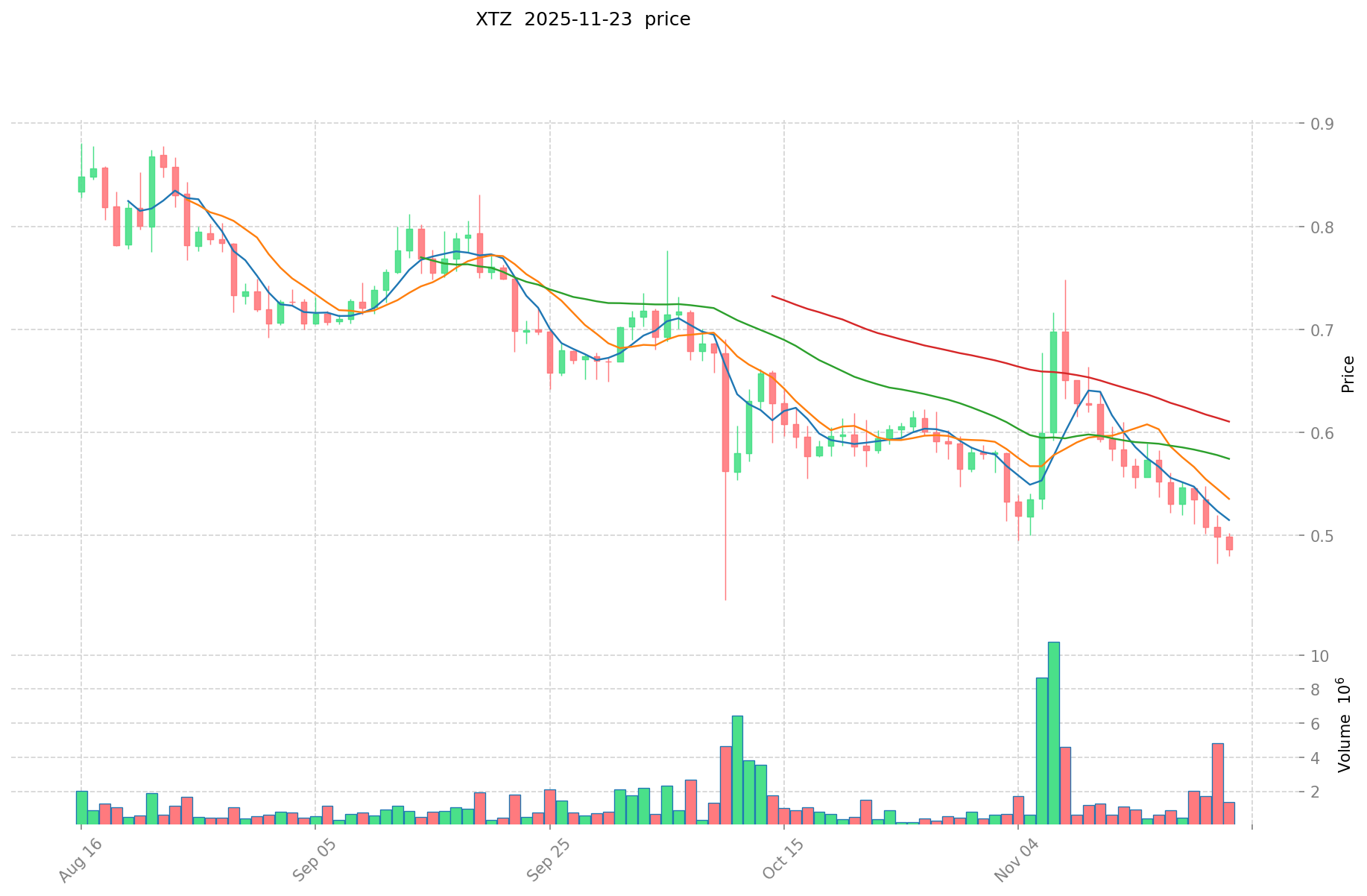SKATE vs XTZ: Comparing Performance and Features of Two Popular Blockchain Platforms
Introduction: Investment Comparison of SKATE vs XTZ
In the cryptocurrency market, the comparison between SKATE and XTZ has always been an unavoidable topic for investors. The two not only have significant differences in market cap ranking, application scenarios, and price performance, but also represent different crypto asset positioning.
SKATE (SKATE): Since its launch, it has gained market recognition for its multi-VM infrastructure capabilities.
Tezos (XTZ): Launched in 2017, it has been hailed as a self-amending blockchain, and is one of the cryptocurrencies with a significant global trading volume and market capitalization.
This article will comprehensively analyze the investment value comparison between SKATE and XTZ, focusing on historical price trends, supply mechanisms, institutional adoption, technical ecosystems, and future predictions, attempting to answer the question most concerned by investors:
"Which is the better buy right now?"
I. Price History Comparison and Current Market Status
SKATE and XTZ Historical Price Trends
- 2025: SKATE reached its all-time high of $0.128 on June 9, 2025, and its all-time low of $0.00987 on October 10, 2025, showing significant volatility within a short period.
- 2021: XTZ hit its all-time high of $9.12 on October 4, 2021, during the broader crypto market bull run.
- Comparative analysis: Over the past year, SKATE has experienced a dramatic decline of 86.68% from its peak, while XTZ has seen a 56.3% decrease in the same period, indicating that SKATE has been more volatile and affected by market conditions.
Current Market Situation (2025-11-23)
- SKATE current price: $0.02042
- XTZ current price: $0.4921
- 24-hour trading volume: SKATE $168,024.19 vs XTZ $404,420.40
- Market Sentiment Index (Fear & Greed Index): 13 (Extreme Fear)
Click to view real-time prices:
- View SKATE current price Market Price
- View XTZ current price Market Price


II. Core Factors Affecting Investment Value of SKATE vs XTZ
Supply Mechanisms Comparison (Tokenomics)
-
SKATE: Fixed supply of 100,000,000 tokens with deflationary model featuring token burns
-
XTZ (Tezos): Inflationary model with annual inflation rate of approximately 5.5%, offset by staking rewards
-
📌 Historical Pattern: Fixed supply assets like SKATE tend to experience more price volatility during bull markets, while XTZ's inflation-with-staking model provides more price stability but potential dilution of value over time.
Institutional Adoption and Market Applications
- Institutional Holdings: XTZ has stronger institutional backing with investments from large funds and financial organizations, while SKATE remains primarily retail-focused
- Enterprise Adoption: XTZ has established partnerships in the banking sector and art markets for settlement systems, while SKATE is targeting gaming and metaverse applications
- Regulatory Attitudes: Both tokens face moderate regulatory scrutiny, with XTZ having clearer regulatory status in most jurisdictions due to its longer market presence
Technical Development and Ecosystem Building
- SKATE Technical Upgrades: Layer-2 scaling solutions and cross-chain integration planned for 2026
- XTZ Technical Development: Smart contract optimization and privacy features in development pipeline
- Ecosystem Comparison: XTZ has a more mature DeFi ecosystem with established lending and staking protocols; SKATE shows promising NFT marketplace growth but less developed DeFi applications
Macroeconomic Factors and Market Cycles
- Performance in Inflationary Environments: XTZ historically shows more stability during high inflation periods
- Macroeconomic Monetary Policy: Both assets show negative correlation with interest rate hikes, with XTZ demonstrating slightly better resilience
- Geopolitical Factors: XTZ benefits from wider global distribution and adoption in regions with currency instability
III. 2025-2030 Price Prediction: SKATE vs XTZ
Short-term Prediction (2025)
- SKATE: Conservative $0.0178 - $0.0205 | Optimistic $0.0205 - $0.0266
- XTZ: Conservative $0.4533 - $0.4927 | Optimistic $0.4927 - $0.6651
Mid-term Prediction (2027)
- SKATE may enter a growth phase, with prices expected in the range of $0.0245 - $0.0419
- XTZ may enter a steady growth phase, with prices expected in the range of $0.3679 - $0.7617
- Key drivers: Institutional capital inflow, ETF, ecosystem development
Long-term Prediction (2030)
- SKATE: Base scenario $0.0395 - $0.0577 | Optimistic scenario $0.0577+
- XTZ: Base scenario $0.7963 - $0.9157 | Optimistic scenario $0.9157+
Disclaimer: This analysis is based on historical data and market projections. Cryptocurrency markets are highly volatile and unpredictable. This information should not be considered as financial advice. Always conduct your own research before making investment decisions.
SKATE:
| 年份 | 预测最高价 | 预测平均价格 | 预测最低价 | 涨跌幅 |
|---|---|---|---|---|
| 2025 | 0.026598 | 0.02046 | 0.0178002 | 0 |
| 2026 | 0.03270531 | 0.023529 | 0.01905849 | 15 |
| 2027 | 0.04189456095 | 0.028117155 | 0.02446192485 | 37 |
| 2028 | 0.03815638519275 | 0.035005857975 | 0.02275380768375 | 71 |
| 2029 | 0.042434101037295 | 0.036581121583875 | 0.024875162677035 | 79 |
| 2030 | 0.057681112513454 | 0.039507611310585 | 0.022519338447033 | 93 |
XTZ:
| 年份 | 预测最高价 | 预测平均价格 | 预测最低价 | 涨跌幅 |
|---|---|---|---|---|
| 2025 | 0.665145 | 0.4927 | 0.453284 | 0 |
| 2026 | 0.712074675 | 0.5789225 | 0.364721175 | 17 |
| 2027 | 0.76168833325 | 0.6454985875 | 0.367934194875 | 30 |
| 2028 | 0.86541995626125 | 0.703593460375 | 0.58398257211125 | 42 |
| 2029 | 0.808041909567668 | 0.784506708318125 | 0.619760299571318 | 59 |
| 2030 | 0.915715455284331 | 0.796274308942896 | 0.485727328455167 | 61 |
IV. Investment Strategy Comparison: SKATE vs XTZ
Long-term vs Short-term Investment Strategies
- SKATE: Suitable for investors focused on gaming and metaverse potential
- XTZ: Suitable for investors seeking stability and inflation-resistant properties
Risk Management and Asset Allocation
- Conservative investors: SKATE: 20% vs XTZ: 80%
- Aggressive investors: SKATE: 60% vs XTZ: 40%
- Hedging tools: Stablecoin allocation, options, cross-currency combinations
V. Potential Risk Comparison
Market Risk
- SKATE: Higher volatility and susceptibility to market sentiment
- XTZ: Relatively more stable but potential value dilution due to inflationary model
Technical Risk
- SKATE: Scalability, network stability
- XTZ: Concentration of baking power, security vulnerabilities
Regulatory Risk
- Global regulatory policies may have different impacts on both assets
VI. Conclusion: Which Is the Better Buy?
📌 Investment Value Summary:
- SKATE advantages: Fixed supply, potential for high growth in gaming and metaverse sectors
- XTZ advantages: More established ecosystem, institutional backing, and relative price stability
✅ Investment Advice:
- Novice investors: Consider a higher allocation to XTZ for stability
- Experienced investors: Balanced portfolio with both assets, adjusting based on risk tolerance
- Institutional investors: XTZ may be more suitable due to its established market presence and regulatory clarity
⚠️ Risk Warning: The cryptocurrency market is highly volatile, and this article does not constitute investment advice. None
VII. FAQ
Q1: What are the main differences between SKATE and XTZ in terms of supply mechanisms? A: SKATE has a fixed supply of 100,000,000 tokens with a deflationary model featuring token burns, while XTZ has an inflationary model with an annual inflation rate of approximately 5.5%, offset by staking rewards.
Q2: Which cryptocurrency has shown better price stability historically? A: XTZ (Tezos) has historically shown more price stability, especially during high inflation periods and market downturns. SKATE has experienced more significant volatility within shorter periods.
Q3: How do SKATE and XTZ compare in terms of institutional adoption? A: XTZ has stronger institutional backing with investments from large funds and financial organizations, while SKATE remains primarily retail-focused. XTZ also has established partnerships in the banking sector and art markets for settlement systems.
Q4: What are the key technical developments planned for SKATE and XTZ? A: SKATE has Layer-2 scaling solutions and cross-chain integration planned for 2026. XTZ is focusing on smart contract optimization and privacy features in its development pipeline.
Q5: How do the long-term price predictions for SKATE and XTZ compare? A: By 2030, SKATE's base scenario price range is predicted to be $0.0395 - $0.0577, with an optimistic scenario of $0.0577+. For XTZ, the base scenario is $0.7963 - $0.9157, with an optimistic scenario of $0.9157+.
Q6: What are the recommended investment strategies for SKATE and XTZ? A: For conservative investors, a suggested allocation is 20% SKATE and 80% XTZ. For aggressive investors, the recommendation is 60% SKATE and 40% XTZ. The specific allocation should be based on individual risk tolerance and investment goals.
Q7: What are the primary risks associated with investing in SKATE and XTZ? A: For SKATE, key risks include higher volatility, market sentiment susceptibility, and technical risks related to scalability and network stability. For XTZ, risks include potential value dilution due to its inflationary model, concentration of baking power, and security vulnerabilities. Both face regulatory risks depending on global policies.
Share
Content